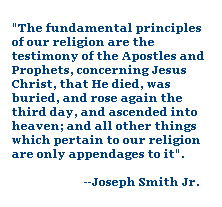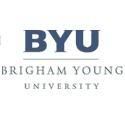Nephite Ark of the Covenant
Don Bradley at fairlds.org presents a paper entitled “Piercing the Veil: Temple Worship in the Lost 116 pages. Brother Bradley comments on some temple-related themes that may have been present in the lost 116 pages. I especially liked his insights in the possible relationship between the items in the Mosaic ark of the covenant (decalogue tablets, manna and rod of Arron) and the Nephite relics (Brass plates, Liahona, and Sword of Laban). Bradley suggests that these Nephite relics may have been placed in a New World version of the ark of the covenant and served a similar purpose.
In the Old Testament after Moses descended Mount Sinai with the decalogue stones and found the Children of Israel worshipping the golden calf, he drew a line in the sand and asked 'who is on the Lord's side?' Only the tribe of Levi stood with Moses. When the Lord bestowed rights to administer in the Temple to the Levites, there was controversy.
So, Moses had a representative from each tribe place their staffs in the court yard of the tabernacle. The next day the tribes of Israel beheld the staff of Aaron had not only sprouted leaves but also yielded almonds. The staff of Aaron was carried in the Mosaic Ark of Covenant and proved Aaron's divine right as High Priest over Israel.
Of particular interest is how these Nephite relics established Nephi's divine right as king and high priest and prove his covenant relationship with the Lord. Monarchs demonstrate the possession of divine right by the possession of the "crown jewels" and various seals and golden-gem encrusted objects. However, the Nephite artifacts were not appreciated for their monetary value but for their spiritual significance.
The importance of the Nephite relics were that 1. it proved Nephi's divine right to rule just as Goliath's sword symbolized David's divine right (JBOMS, Ben McGuire) 2. it convinced the Lamanites of the Nephites right to rule despite their false tradition that Nephi had stolen the artifacts from Laman and Lemuel. 3. The relics proved to the Mulekites and King Zarahemla that the Nephites possessed the divine right.
This is significant as Mulek was the son of King Zedekiah. Also, the Mulekites outnumbered the Nephites 2:1. So, you think there would be controversy over which king, Zarahemla or Mosiah would rule. As it happened, the Mulekites peacefully united with and submitted to King Mosiah's rule and became Nephites.
If the unification of the Mulekites and Nephites is a type and shadow of the future unification of the Jews (Judah) and the Mormons (Joseph), I wonder if the modern LDS Church possesses similar artifacts that prove its divine right and covenant relationship with Hashem.
The other tidbits I enjoyed about Brother Bradley's paper was his comments on Fayette Lapham's account of what was contained in the lost 116 pages of the Book of Lehi. According to Lapham who had spoken with Joseph Smith Sr., the 116 pages gave an account of how the Nephites discovered the Jaredites interpreters or Urim and Thummin.
Lapham says the Nephites were led by the Liahona to the interpreters. After finding the interpreters, the person who finds them enters the Tabernacle to inquire of the Lord. Lapham says that the Voice of the Lord asks: "What is that in your hand?” And Lapham says the man responded that “he did not know but that he had come to inquire." So, we have this great motif of speaking with the Lord at the veil of the temple. The Brother of Jared had a similar experience.
The other details Brother Bradley suggests must be contained in the Lost 116 pages likely contained an account of how Aminadi (Joseph and Daniel type) used the interpreters to translate an inscription on the walls of the temple. Aminadi is only briefly mentioned by Mormon to introduce Amulek in Alma 10. It is clear that when Mormon says "that same Aminadi", he assumes the reader should already know Aminadi's story.
In any event, I am overall impressed with the significance of the discovery of the Mulekites by the Nephites in the New World. I am sure that there was some controversy over whether the City of Jerusalem had actually been destroyed. But God says he will "prove all his words with power and great glory." here we have not just another group of Jews who escaped Jerusalem but Mulek, one of King Zedekiah's sons.
When it comes to controversy today with regard to the historicity of the Book of Mormon, I am confident that at some point the Lord will also prove these words. But for now, we are told that the Lord is proving the Gentiles whether we will humble ourselves to do the will of God (charity) and not follow after our own will (pride).













1 comment:
The real Ark of the Covenant is in America and will soon be revealed to the world, I.e. Doctrine & Covenants 85:7-8 and Doctrine & Covenants 103:14-20
http://youtu.be/5O43uNxSr1Q
Post a Comment